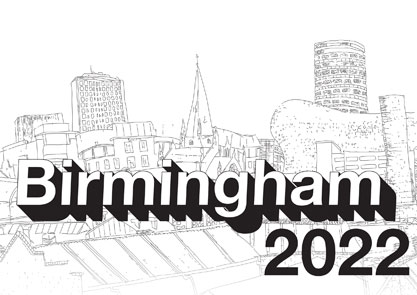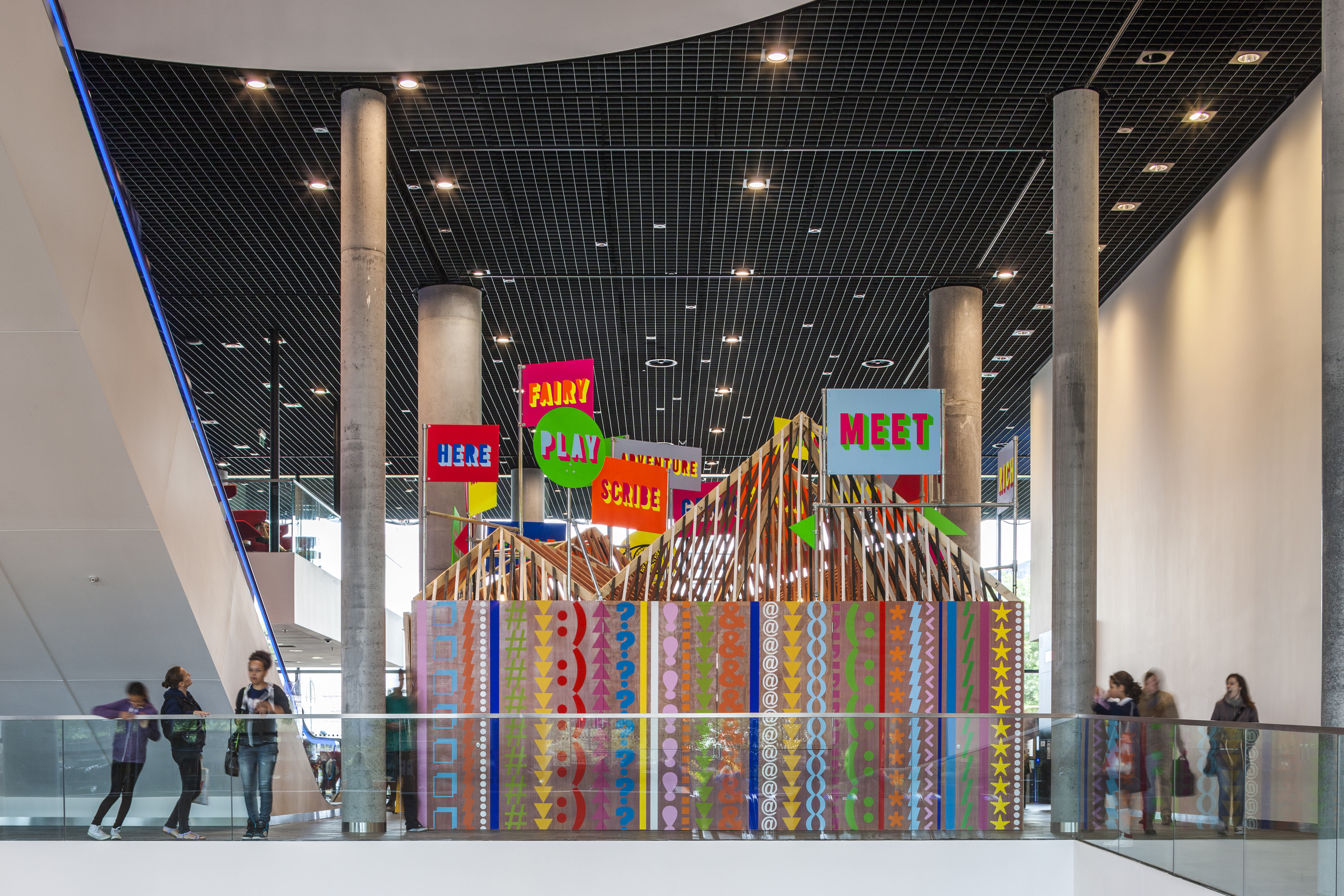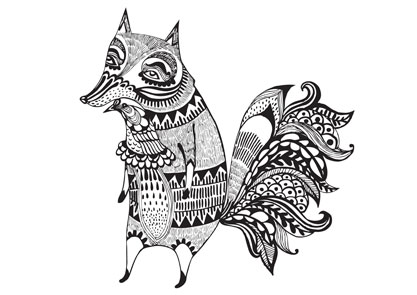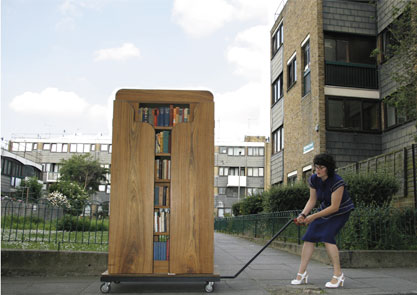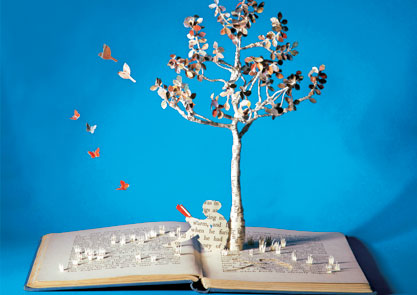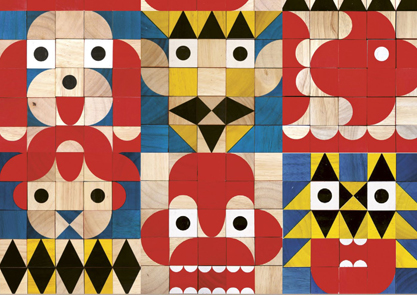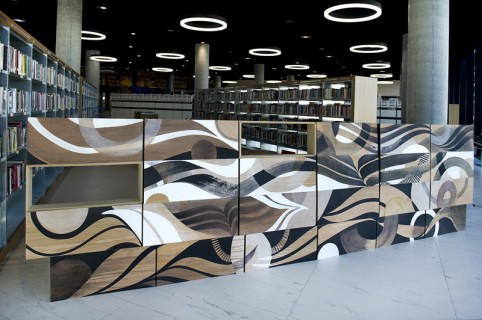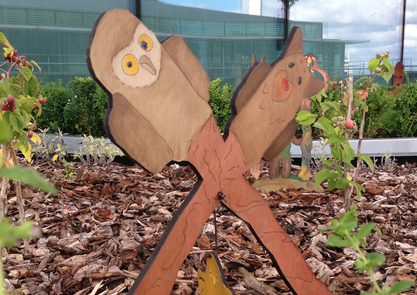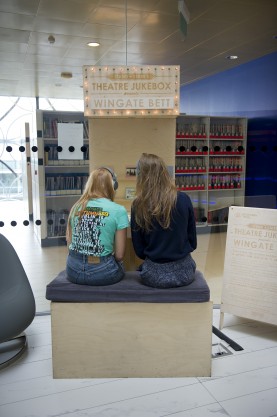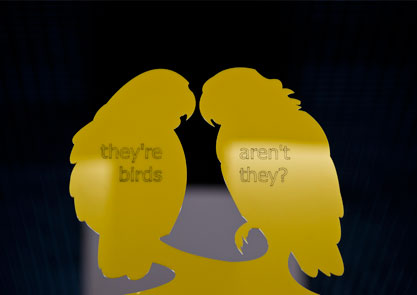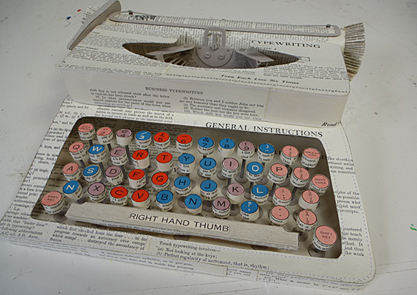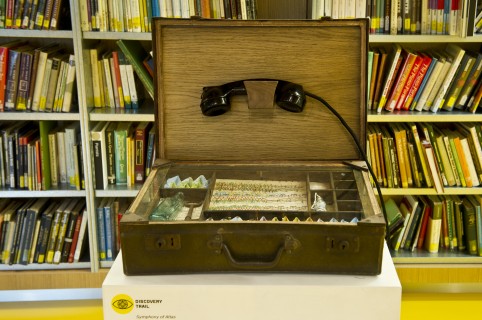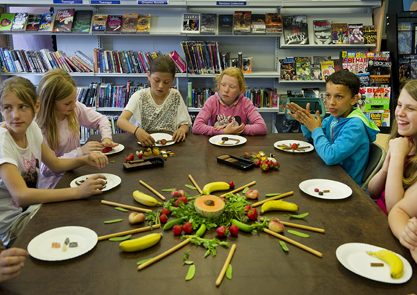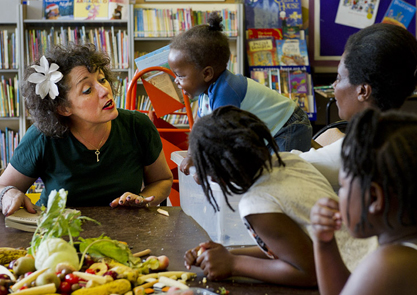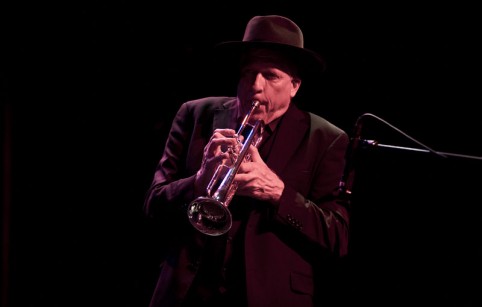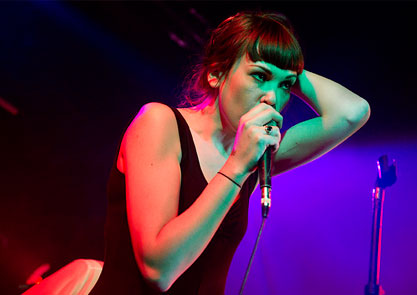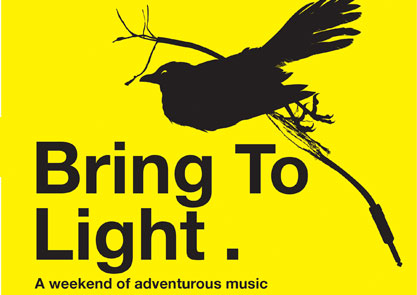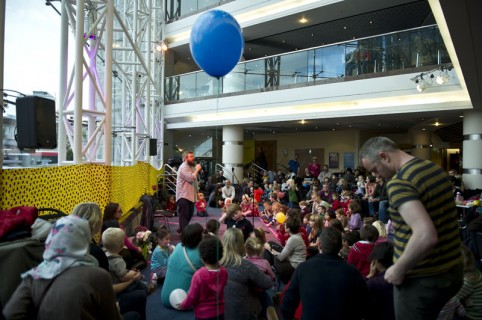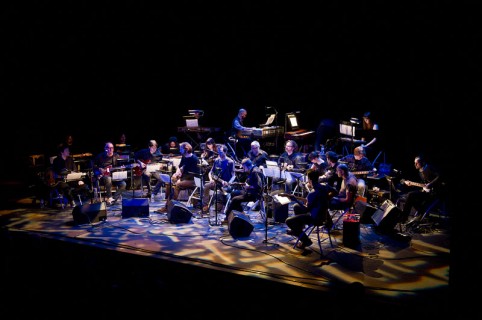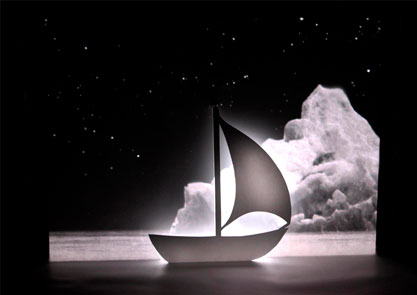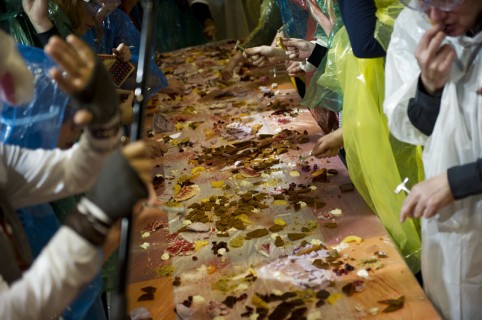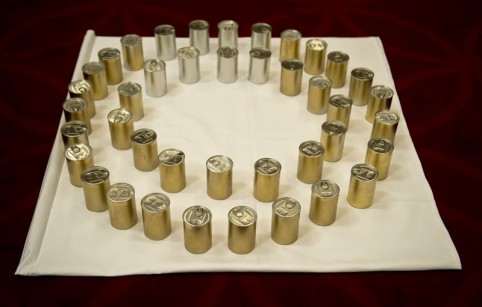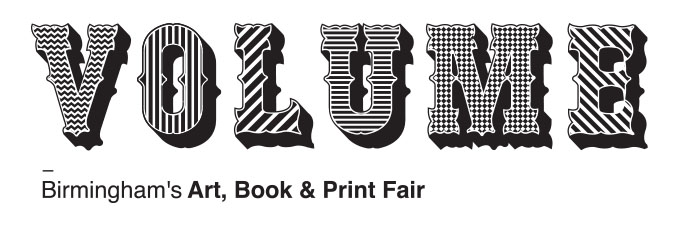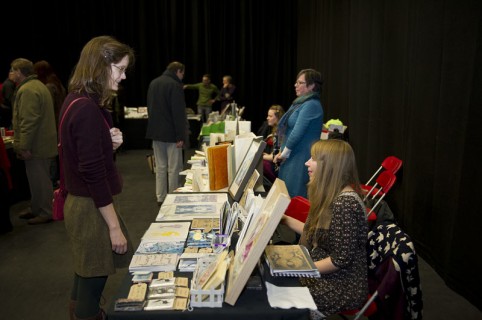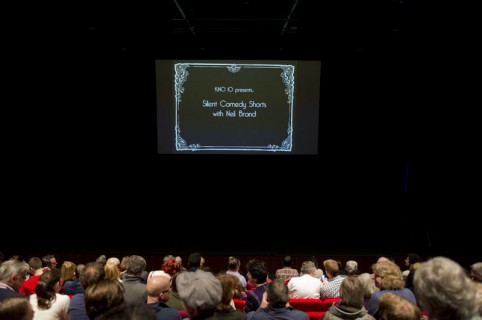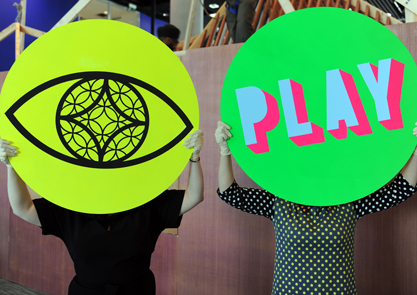
The Pavilion hosted a rolling programme of Creative Residencies. Artists, film makers, book makers and a range of other creatives set up home in The Pavilion for a week at a time, making new work and offering a variety of free activities for Library visitors.
Each week, visitors entering the space were treated to a different experience, ranging from interactive pieces such as audience inspired theatre and film workshops to exhibitions of sci-fi sculptures made from junk and artefacts honouring lost mythical deities. The Library’s collections and literary resources inspired much of the programme, and each residency encouraged audiences to discover something new in the Library of Birmingham.
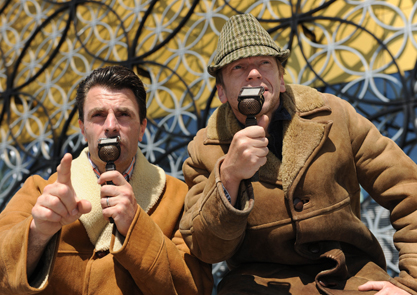
The Commentators – Stan’s Cafe
The Commentators, brought to you by theatrical provocateurs and internationally renowned performance company Stan’s Cafe, carefully documented everything they saw, from the vital, to the peculiar, or the mundane. Which books were being borrowed? What was the weather like on the rooftop terrace? The queues for the large print romances!
The Commentators broadcast live via webcast radio from The Pavilion for the first three days of opening.
Self Portrait Birmingham – Brian Homer
The life-blood of a community is its people, and no one knows this better than photographer Brian Homer. Brian is enthusiastic about recording locality through self-portraits, and is giving Birmingham the opportunity to celebrate its homegrown individuals. Brian developed the Birmingham Self Portrait project, with the aim of capturing each Brummie’s personality, and creating a snapshot of contemporary life. The shutter release cable (a remote controlled camera switch) is designed to aid the subject in portraying themselves in the light they desire. His rationale is visible when he says ‘there is a clear difference to the portraits where the photographer remains in control’, wishing for every unique personality to shine, he allows people to be their own photographer.
As one of the crucial figures involved in the Handsworth self portrait project in 1979, Brian’s current version is a direct development of this project on a larger scale. The original images were stored in the city’s Central Library, so it only seems fitting that this modern day re- imagining was introduced to the opening of the new Library. New photographs were taken during the Discovery Festival, and uploaded to big screens so that they could be viewed quickly after being shot. The photographs were stored in the archives of the new library, for future generations to enjoy. As well as representing and celebrating the cultural diversity of modern Birmingham, these images hope to give an insight into modern life. Self Portrait Birmingham
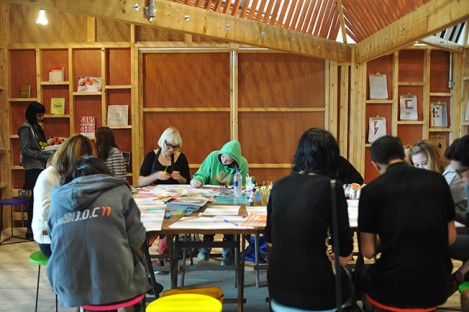
Studio Myerscough
Taking up residency in their own pavilion, Studio Myerscough presented a number of print based workshops allowing audiences to interact with The Pavilion’s dynamic aesthetic. Famous for integrating graphic design into architectural settings, Morag Myerscough has transformed the discipline by going past the typical 2D boundary. Her work, which is situated in a range of unique settings, from cafes to trains to warehouses, uses graphics to encourage its inhabitants to engage with their surroundings.
Morag is conscious of how people feel and react in a space. Central to her pieces is the act of handing the newly made places over to their occupants; their meaning is located in how they evolve and change and belong to the public. Speaking on her work at the library she states ‘What you see at the beginning hopefully won’t be how it exists at the end’, underlining that her work will continue to grow long after her residency has ended.www.studiomyerscough.com
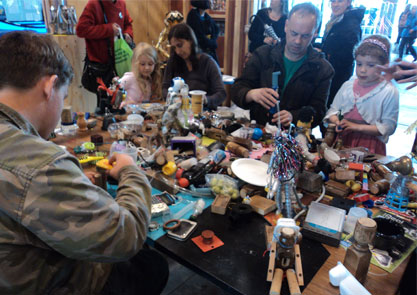
Vintage Sci Fi – 2arttoyguys
Taking inspiration from the adventurous Science Fiction novels of H.G Wells, Jules Verne and Edgar Rice Burroughs, they have created three models of iconic literary machines and characters for the Discovery Season using recycled material, obsolete technology and a healthy dose of the imagination.
Included in this exhibition were DIY interpretations of the Martian War Machines from the War of the Worlds and an astonishing full- size (but sadly non-functioning) replica of Wells’ Time Machine, manufactured from scrap, junk and all manner of unwanted debris – futuristic toys crafted from the relics of the past. As practising artists based in a studio at the Custard Factory, the duo have always utilised their creativity and enthusiasm to produce toys and models spurred by their fond childhood memories of reading pulp magazines entitled ‘Tales of Tomorrow’ and watching classic television programmes such as Thunderbirds.
Trevor and Steven clearly strive to re-awaken and instil the innocent feelings of joy and happiness that are so prevalent in childhood into their work. www.youtube.com/user/2arttoyguys/videos
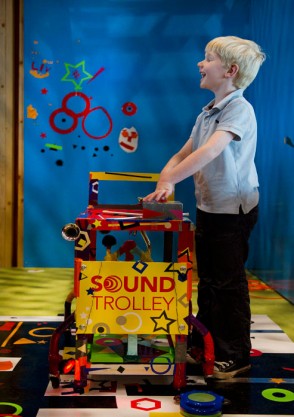
The Sound Trolley – MortonUnderwood
The Sound Trolley, a collaborative project between David Morton and Sam Underwood, a duo of innovative and experimental musicians and instrument makers, is a whimsical audio creature that contains an array of electronic and acoustic sounds. It is controlled through an accessible interface and features an optical sequencer at its core; triggering sound as the trolley is pushed around on floor patterns made from vinyl. The designs were determined what sound the trolley emitted when it was manoeuvred over them. It was a playful vehicle of sonic delights. www.mortonunderwood.co.uk
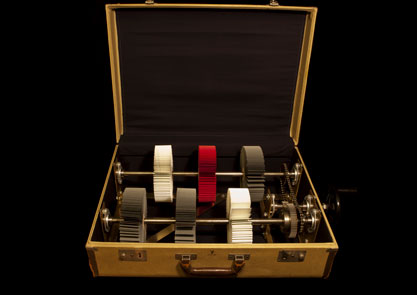
The Book Apothecary Presents: Transcibe by Ben Freeth & Yvetter Hawkins
Book Apothecary is a travelling museum of artist’s books. The project was established in 2011 by visual artist Yvette Hawkins and seeks to provide a platform for artists to make and exhibit artist’s books within the North East region and beyond. For their Creative Residency the Book Apothecary presents a new site specific installation Transcribe by Ben Freeth and Yvette Hawkins. www.bookapothecary.co.uk
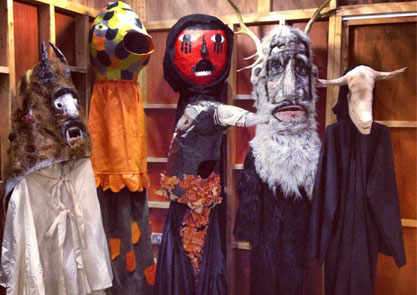
The House of Beorma Archive – The Outcrowd
Building on their project The Festival of The Rea that took place in 2012 The Outcrowd Collective turned The Pavilion into a museum of fictional and real archival material around ‘Beorma’ the chieftan of the Beormingas clan who are the first known Anglo-Saxon settlers and founders of Birmingham. Drawing on Benjamin Stone’s photographs of rural procession and folk celebrations – held in the Library of Birmingham’s archives’ – The Outcrowd also presented re-imagined celebrations and rituals to Beorma. www.outcrowdcollective.blogspot.co.uk
Carousel. A live tape/slide workshop
A Vivid Projects commission from artist Cathy Wade. Carousel was a participatory interdisciplinary work using projections within a collective immersive environment that explores ownership, time, sound and image. The public worked with the artist to experience hand held projectors or carousels, with original slides and mementos, to create ever changing projected environments that had to be immediately experienced. www.vividprojects.org.uk

Scott Johnston (Film Ficciones)
The magic lantern was an important source of entertainment and edification in the nineteenth century, and its transitions and visual tricks pointed the way towards the medium that would eventually supplant it; the cinema. Birmingham produced lanterns and slides for a global market, taking an instrumental role in visual culture, which continued with the patenting of the kineograph (aka the flipbook), the production by Alexander Parkes of a celluloid prototype, and onwards into the twentieth century and cinema’s early ‘Wild West’ period. Artist Scott Johnston used the Library’s Pumphrey slide collection as a starting point to explore early techniques of creating moving image . www.vimeo.com/filmficciones
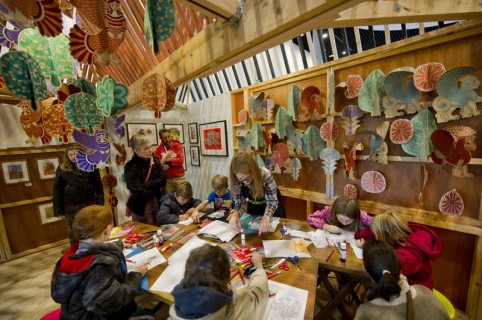
The Museum of Mythical Creatures – Girls Who Draw
The museum was a collection of magical characters, fabulous beasts and imaginary beings inspired by myths, legends and folklore from around the world. Created by illustrators Girls Who Draw, they have painted, printed, cut, drawn and even sewn an array of imaginative artwork and unusual objects to inspire, intrigue and entertain visitors of all ages. Over the last few years Girls Who Draw has evolved from a small group into a larger network including both emerging and established illustrators. Most have been brought together through their involvement in printmaking and self-publishing; creating their own fanzines, comics, and artist’s books. They work together in order to publish a postcard book once a year and each new book is accompanied by an exhibition. www.girlswhodraw.wordpress.com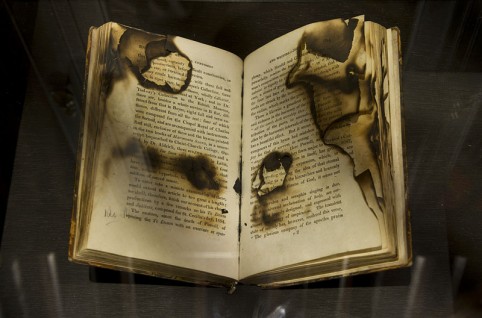
The Library of Lost Books
The Library of Lost Books was an exhibition of book art by over 40 UK artists and was accompanied by a three day conference, Resurrecting the Book. The project was the brainchild of Birmingham based artist Susan Kruse in 2011 as a way to celebrate the move from the old Central library to the new Library of Birmingham in 2013. She assembled a collection of the library’s unwanted, damaged books and sent them to more than 40 artists and printmakers from around the UK to re-work, breathing new life into them through their interactions and interventions. Because many of the books are old, or obscure, this was a unique opportunity for artists to work with books, manuscripts, papers, typefaces and bindings that they might not otherwise have an opportunity so to do. www.thelibraryoflostbooks.blogspot.co.uk
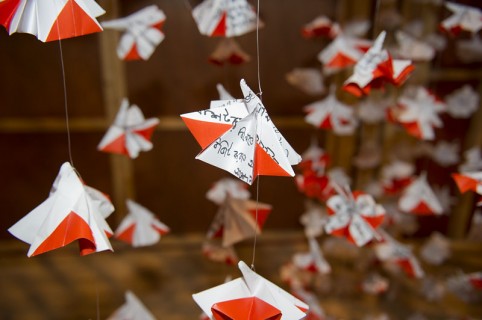
Craftspace and artist Jivan Astfalk with Shelanu
An exploration of migration to Birmingham in collaboration with artist Jivan Astfalk, Shelanu and MA students from the School of Jewellery.
Craftspace is a crafts development organisation based in Birmingham established in 1986. Working to push boundaries and perceptions of crafts practice, presentation and learning through building relationships between artists, people and organisations. www.craftspace.co.uk
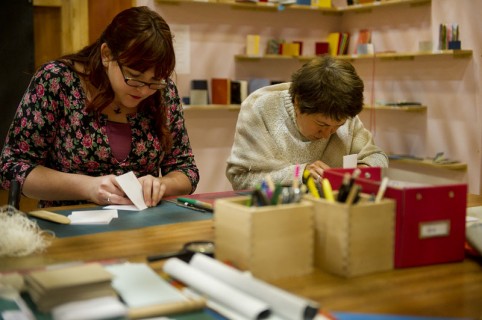
Haworth + Hayhoe – The Library Project
Haworth + Hayhoe installed a miniature interactive library. The Library Project was originally developed with Abigail Conway at Koganecho Bazaar 2012, it builds a local library where all the books are made and written by you. Haworth + Hayhoe ranrunning daily bookbinding workshops, so that participants could write their own book, or draw their own graphic novel, or share family secret recipes. The completed book were shelved and catalogued as part of our library, after which the books created by participants joined a growing collection that will travel the world as part of The Library Project. www.haworthandhayhoe.com
Extra Special People – Eastside Projects
Extra Special People (ESP) is Eastside Projects’ Associates scheme for art graduates, supporting the development of work, ideas, connections and careers through a programme of events, opportunities and projects. www.extraspecialpeople.org
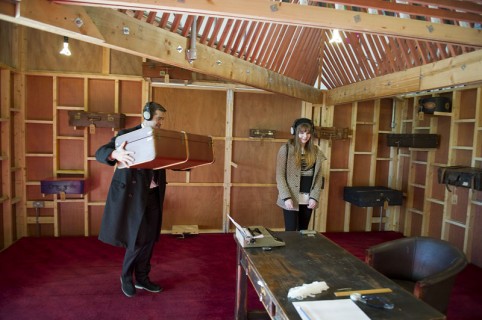
Bureau of Lost Discoveries – Eric MacLennan
A suitcase and a sense of adventure go hand in hand so there is a reason that the suitcase features so prominently in film and fiction. Whether it is a box of memories, exploits, danger or just the everyday, it has the potential to be filled with a sense of wonder. Playing on this intriguing atmosphere, Scottish theatre maker Eric MacLennan has invented an installation that is both performance and art.
The creator of many bold, audience based works over the last twenty-eight years, MacLennan uses entertainment to encourage his spectators to think. Inspired by the writing of Xavier De Maistre, who was devoted to uncovering the interesting in everyday life, MacLennan wishes to encourage an audience to discover the exciting aspects in their own world. In his realm, you’ll learn that the norm can become extraordinary and new.
MacLennan’s desire to take part in the Discovery Season was so that he could create theatre in a non-theatre setting. The aim is for the viewer to experience the excitement felt when watching a performance, but in the style of a special encounter. MacLennan’s set up allows the spectator to instantly become involved in the story, and to become a character in their own personal adventure.
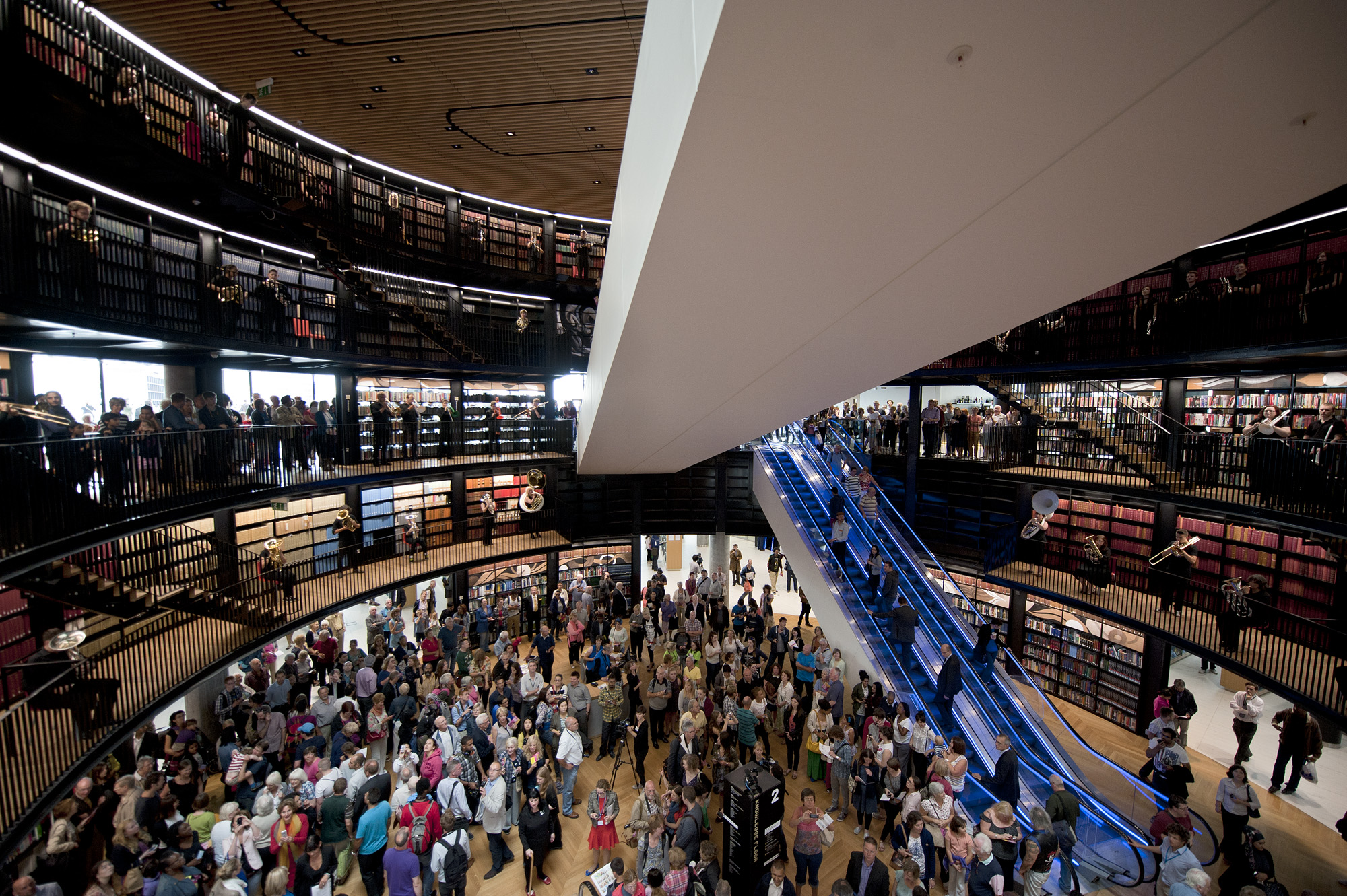 Sound artists
Sound artists 